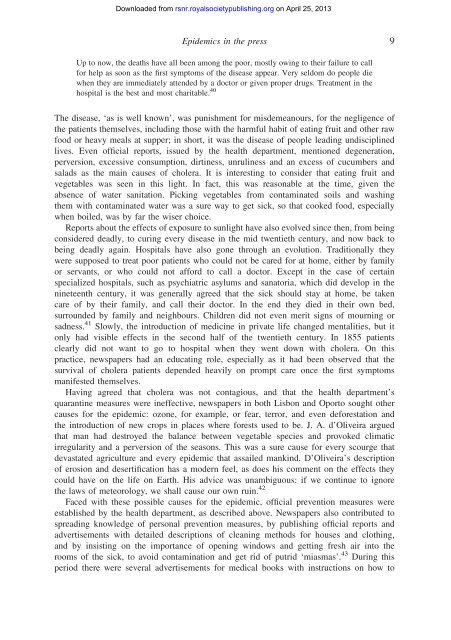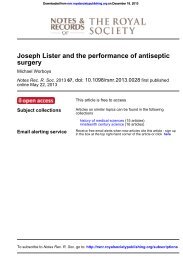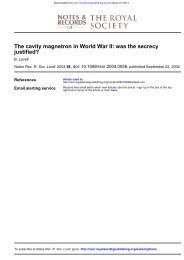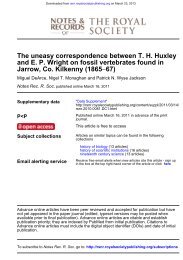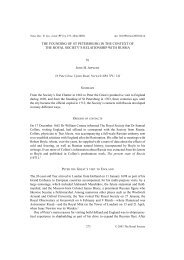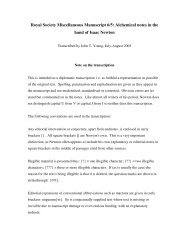THE PORTUGUESE CHOLERA MORBUS EPIDEMIC OF 1853–56 ...
THE PORTUGUESE CHOLERA MORBUS EPIDEMIC OF 1853–56 ...
THE PORTUGUESE CHOLERA MORBUS EPIDEMIC OF 1853–56 ...
Create successful ePaper yourself
Turn your PDF publications into a flip-book with our unique Google optimized e-Paper software.
Downloaded from<br />
rsnr.royalsocietypublishing.org on April 25, 2013<br />
Epidemics in the press 9<br />
Up to now, the deaths have all been among the poor, mostly owing to their failure to call<br />
for help as soon as the first symptoms of the disease appear. Very seldom do people die<br />
when they are immediately attended by a doctor or given proper drugs. Treatment in the<br />
hospital is the best and most charitable. 40<br />
The disease, ‘as is well known’, was punishment for misdemeanours, for the negligence of<br />
the patients themselves, including those with the harmful habit of eating fruit and other raw<br />
food or heavy meals at supper; in short, it was the disease of people leading undisciplined<br />
lives. Even official reports, issued by the health department, mentioned degeneration,<br />
perversion, excessive consumption, dirtiness, unruliness and an excess of cucumbers and<br />
salads as the main causes of cholera. It is interesting to consider that eating fruit and<br />
vegetables was seen in this light. In fact, this was reasonable at the time, given the<br />
absence of water sanitation. Picking vegetables from contaminated soils and washing<br />
them with contaminated water was a sure way to get sick, so that cooked food, especially<br />
when boiled, was by far the wiser choice.<br />
Reports about the effects of exposure to sunlight have also evolved since then, from being<br />
considered deadly, to curing every disease in the mid twentieth century, and now back to<br />
being deadly again. Hospitals have also gone through an evolution. Traditionally they<br />
were supposed to treat poor patients who could not be cared for at home, either by family<br />
or servants, or who could not afford to call a doctor. Except in the case of certain<br />
specialized hospitals, such as psychiatric asylums and sanatoria, which did develop in the<br />
nineteenth century, it was generally agreed that the sick should stay at home, be taken<br />
care of by their family, and call their doctor. In the end they died in their own bed,<br />
surrounded by family and neighbours. Children did not even merit signs of mourning or<br />
sadness. 41 Slowly, the introduction of medicine in private life changed mentalities, but it<br />
only had visible effects in the second half of the twentieth century. In 1855 patients<br />
clearly did not want to go to hospital when they went down with cholera. On this<br />
practice, newspapers had an educating role, especially as it had been observed that the<br />
survival of cholera patients depended heavily on prompt care once the first symptoms<br />
manifested themselves.<br />
Having agreed that cholera was not contagious, and that the health department’s<br />
quarantine measures were ineffective, newspapers in both Lisbon and Oporto sought other<br />
causes for the epidemic: ozone, for example, or fear, terror, and even deforestation and<br />
the introduction of new crops in places where forests used to be. J. A. d’Oliveira argued<br />
that man had destroyed the balance between vegetable species and provoked climatic<br />
irregularity and a perversion of the seasons. This was a sure cause for every scourge that<br />
devastated agriculture and every epidemic that assailed mankind. D’Oliveira’s description<br />
of erosion and desertification has a modern feel, as does his comment on the effects they<br />
could have on the life on Earth. His advice was unambiguous: if we continue to ignore<br />
the laws of meteorology, we shall cause our own ruin. 42<br />
Faced with these possible causes for the epidemic, official prevention measures were<br />
established by the health department, as described above. Newspapers also contributed to<br />
spreading knowledge of personal prevention measures, by publishing official reports and<br />
advertisements with detailed descriptions of cleaning methods for houses and clothing,<br />
and by insisting on the importance of opening windows and getting fresh air into the<br />
rooms of the sick, to avoid contamination and get rid of putrid ‘miasmas’. 43 During this<br />
period there were several advertisements for medical books with instructions on how to


